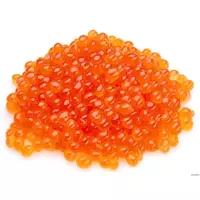Red caviar

In our country, red caviar has long been considered a delicacy, however, despite the high price, it is not difficult to buy this product at present. But this was not always the case: previously, local residents of the Far East did not consider it a special product, but, knowing about the nutritional value and beneficial properties of red caviar, it was given to sled dogs. Well, let's try to figure out why red caviar is so highly valued, which is its useful properties, possible benefits and harm.
It is known that red caviar is given to us by salmon fish - chum salmon, pink salmon, sockeye salmon, trout and coho salmon. In terms of useful properties and composition, all eggs are almost the same, differing only in size, appearance and taste. For example, the caviar of chinook fish is the largest (approximately 7 mm in diameter) and has a bright red color and bitter taste. Unfortunately, we will not get acquainted with the taste of these giant eggs, due to the fact that chinook salmon has long been listed in the Red Book.
In second place in size is red chum caviar, which has the correct ball shape and bright amber color. Previously, this caviar was called "royal, " although not many like its taste, and it is used mainly to decorate dishes.
The most versatile red caviar that is in demand among most consumers can undoubtedly be called pink salmon caviar - one of the most prolific fish among salmon species. The light orange eggs of this fish reach 5 mm, while the shell is not very dense.
Sockeye salmon red caviar practically does not differ in taste from pink salmon caviar, but in size it is slightly smaller (4 mm), and it is difficult to find it, due to the massive extermination of this type of fish.
Such a noble fish as trout has the smallest caviar, which is only 2-3 mm in diameter. It is noteworthy that the color of its shell varies from pale yellow to saturated orange. By the way, recently it has been the red caviar of trout that has massively entered the consumer market.
Let's not forget about coho salmon, whose caviar is not particularly in demand due to its small size and bitter taste. Although it is called red, it actually has a burgundy color.
Red caviar benefits
It is easy to explain the benefits of red caviar, since caviar is nothing more than a fish egg, which contains everything you need, which is laid down by nature in order for the embryo to fully develop. However, to get the most out of it, this product doesn't have to be eaten in large quantities at all. A safe dose, in which the benefits of red caviar will not turn into harm, is considered about 2-3 sandwiches with caviar or 5 teaspoons per meal.
Eating red caviar in reasonable doses is an excellent prophylactic to boost immunity. In addition, the use of this gift of the sea has a beneficial effect on vision and contributes to the strengthening of bones. The beneficial properties of red caviar are justified by the ability to improve blood circulation, while significantly reducing the risk of blood clots, and, therefore, the occurrence of cardiovascular diseases.
Red caviar harm
Despite the general adoration and numerous beneficial properties of red caviar, one cannot fail to note several important points that should be taken into account using this food product. Thus, sodium in red caviar retains fluid in the body, which leads to a violation of metabolic processes.
When we say these two magic words - red caviar - we first imagine a sandwich with fragrant white bread and delicate butter, don't we? And I don't want to think at all that with a fairly high calorie content of red caviar, it is in this form that we consume rather heavy (albeit very tasty) food for the stomach. Yes, and do not forget: in order not to face the possible harm of red caviar, it must be, first of all, of excellent quality.
red caviar 249 kCal
Energy value of red caviar (Ratio of proteins, fats, carbohydrates - ju):
Proteins: 31.5 g (~ 126 kCal)
Fats: 13.2 (~ 119 kCal)
Carbohydrates: 1g (~ 4kCal)
Energy ratio (bj | y): 51% | 48% | 2%
 Español
Español Français
Français Português
Português Русский
Русский 简体中文
简体中文 繁體中文
繁體中文 日本語
日本語 한국어
한국어 العربية
العربية Türkçe
Türkçe Қазақ
Қазақ Deutsch
Deutsch Italiano
Italiano Українська
Українська
